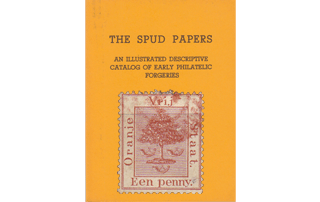Spud Papers – Orange Free State


 One Penny, Six Pence and One Schilling.
One Penny, Six Pence and One Schilling.
All the values, both of the genuine and counterfeit, are from one matrix respectively. In the forgery, the tree has a whity washed-out look, and the “bullets” thereon are very distinctly visible. Otherwise, this is a very good imitation. It is difficult to seize upon any salient point, whereby to give a written test for its detection; but as the forgery itself is here given, it will suffice to say that the original is very finely engraved, and upon the usual glace paper adopted by De La Rue & Co., in both of which instances the forgery decidedly differs. The genuine is clearly perforated with thirteen dents above; but the counterfeits are badly perforated.
1868. 1d., 6d. & 1s.
These forgeries are remarkably well copied; and I can assure our readers that I have found great difficulty in picking out any very salient points of difference between them and the genuine. The penny, especially, would pass muster very well, at a little distance; and will, I fancy, be the means of directing much coin from the pockets of our innocent young friends into the not too clean hands of Messrs. Spiro and their wholesale customers.
Genuine
Engraved in épargne, on thin white wove, slightly surfaced paper; perf. 14. There are 79 horizontal lines in the central portion, and there is nearly room for another line at the bottom. The top of the tree touches the top line of the background, but does not go above it. The loops by which the post-horns are suspended, are large enough to allow one of the lines of the background to be seen through them in every case. Near the thick end of each horn, there are two thin lines, as though something were bound round it; and a very little further off (i.e., where the cord is tied to the thick end) there are three similar lines on each horn. The knot in the center of the trunk of the tree, where a branch has been lopped off, occupies a space bounded by three of the horizontal lines. The N and j of ORANJE do not touch each other. The stop after STAAT is large.
Forgery
Lithographed, on unsurfaced white wove paper, rather thick; perf. 12 and 12 1/2. There are only 74 horizontal lines in the background, and they come close up to the inner frame at both top and bottom, leaving no room for the addition of another line. The top of the orange-tree goes a little beyond the top line of the groundwork, and touches the inner border of the frame under the curl of the R in VRIJ. The loops of the posthorns are very small, and the left hand one is the only one which allows a line of the background to be seen through it. Near the thick end of the horns only four lines can be seen, instead of five, running round the body of the horns. The knot in the trunk of the tree is larger than in the genuine; and occupies a space bounded by four of the horizontal lines. The tails of the N and J in ORANJE touch each other. The stop after STAAT is very small, merely a tiny dot; and the lettering is all rather thinner than in the genuine. Printed in sheets of 25, 5 x 5 , and postmarked with the old Spanish “gridiron.”
I fancy that, in the originals, the 1d. and 1 /. are of a different type from the 6d., but the difference is so very slight as to be hardly worth mentioning.
From “The Spud Papers” by Atless, Pemberton & Earée, 1871-1881.

